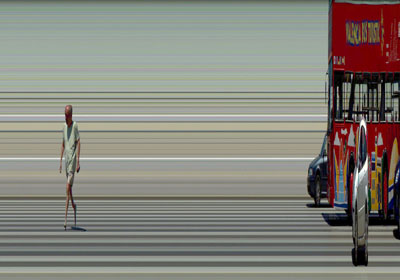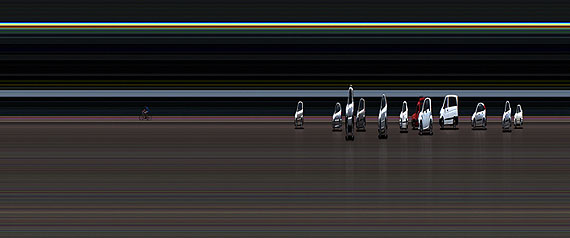
El Anarquista y el Automóvil, detail, 2008
photograph 90 x 864 cm
Jay Mark Johnson »
El Anarquista y el Automóvil
Exhibition: 9 Sep – 10 Dec 2011
Fri 9 Sep 19:00

Galerie Deschler
Auguststr. 61
10117 Berlin
+49 (0)30-2833288
info@deschler-berlin.de
www.deschler-berlin.de
Tue-Sat 12-18

El Anarquista, el banquero y el Automóvil, 2008
photograph 90 x 523 cm
In order to understand the large-format photographs of American artist Jay Mark Johnson (*1955) it is crucial to grasp their underlying paradox: while the images are created purely photographically, without digital manipulation or staging of a scene, and therefore depict actual events, they still create a perfectly illusory pictorial world. Johnson employs a modified camera which over a set period of time keeps recording the same narrow vertical strip in front of the camera lens and combines the successive photographs into an uninterrupted image that flows evenly from left to right. The vertical axis thus retains its spatial dimension, but the horizontal axis is dedicated to a depiction of the passage of time: "x = time." Immobile elements appear as a homogenous background of horizontal lines, only elements (figures, vehicles, etc.) that move through the recording plane assume a life of their own as recognizable if stretched or squashed shapes (depending on their speed).
Johnson's hybrid combination of spatial and temporal dimensions links back to art historical precursors, above all the chronophotographic studies of movement of the late 19th century (Eadweard Muybridge, Étienne Jules Marey, Albert Londe et al.), as well as Italian Futurism (alluded to in the title with its mention of anarchism and automobiles). But Johnson both visually and methodologically goes beyond a purely technical experimentation by consciously exploiting the permutations and shifts effected by his recording process to examine, on a level of content, the nature and limits of our modes of perception. While his earlier works depicted dancers as amorphous shapes whose complex movement patterns were recorded in a kind of "action painting," his newer photographs play with the illusions brought about by a visual approximation of his time-images to conventional spatial images, while purposefully retaining a remnant of their comical distortions. For even a precise understanding of the creation process will not keep us from perceiving the temporal axis as spatial, for in the image it is spatial.
A remarkable effect of the recording process that combines the image from successive individual photographs is the fact that the figures in the image always move in the same direction. This is the result of the camera writing the image in one direction: a figure would only appear to move in the opposite direction if it moved backwards through the recording plane. The camera thus effectively imposes an order and homogeneity onto the depicted reality that was never there in the first place. Johnson's subtitle for the exhibition, "Between Don Quijote and Pied Piper," is therefore not coincidental. The famous literary figure of Don Quijote lives in a world of appearances shaped by the idealized rules of a bygone era. Both the comical as well as the tragic moments of this figure are due to the clash of his conceptions with the harsh reality of his time, and to his contemporaries his stubborn insistence on his ideals seems like a form of insanity. The same goes for the anarchist who does not want to accept the reality of urban motor vehicle traffic: he, too, is fighting proverbial windmills. At the same time, however, we cannot do without the visions of people who break through established patterns of thought and perception, in order to lead us to new shores, no matter how absurd their visions might at first seem. For we ignore them at our own peril and might have to suffer the fate that befell the citizens of Hamelin in the story of the Pied Piper: that the price we ultimately have to pay for our blindness is higher than we can afford. [Text: Martin Oskar Kramer]
Entscheidend für das Verständnis der großformatigen Fotografien des amerikanischen Künstlers Jay Mark Johnson (*1955) ist das ihnen zugrundeliegende Paradox, dass die Arbeiten rein fotografisch zustande kommen und tatsächliche Ereignisse in der Welt abbilden, es sich also weder um digitale Manipulationen noch um eine inszenierte Wirklichkeit handelt, sie aber dennoch eine völlig illusorische Bildwelt schaffen. Johnson verwendet eine modifizierte Kamera, welche über einen bestimmten Zeitraum immer wieder denselben schmalen vertikalen Streifen aufnimmt und diese sukzessiven Aufnahmen zu einem lückenlos von links nach rechts fließenden Bild zusammenfügt. Die vertikale Achse bleibt als räumliche Dimension erhalten, während die horizontale Achse der zeitlichen Dimension gewidmet ist: "x = time". Reglose Bildelemente erscheinen als gleichförmiger Hintergrund horizontaler Linien, nur Elemente (Figuren, Fahrzeuge, etc.), die sich durch die Aufnahmeebene bewegen, gewinnen ein Eigenleben und setzen sich als (je nach Geschwindigkeit) gestauchte bzw. gestreckte Gestalten ab.
Johnsons hybride Verbindung räumlicher und zeitlicher Dimensionen bezieht sich zwar auf kunsthistorische Vorläufer, vor allem auf die chronofotografischen Bewegungsstudien des späten 19. Jahrhunderts (Eadweard Muybridge, Étienne Jules Marey, Albert Londe u.a.) und auf den italienischen Futurismus, auf den auch der Titel der Ausstellung mit den Begriffen "Anarchismus" und "Automobil" anspielt. Doch geht Johnson visuell und methodologisch über eine rein technische Spielerei hinaus, indem er die durch die Aufnahmetechnik bedingten Umkehrungen und Verschiebungen bewusst inhaltlich einsetzt, um unsere Wahrnehmungsmechanismen zu hinterfragen. Während seine früheren Arbeiten Tänzer als amorphe Gestalten zeigten, deren komplexe Bewegungen in einer Art von "action painting" erfasst wurden, spielen die neueren Fotos mit den Illusionen, die durch das visuelle Angleichen – bei gewolltem Bewahren komischer Verzerrungen – seiner Bilder an räumliche Bilder entstehen. Denn selbst bei genauem Verständnis der Entstehungsweise werden wir die horizontale Zeitachse zwangsläufig räumlich wahrnehmen, denn im Bild ist sie räumlich.
Ein bemerkenswerter Effekt der Aufnahmetechnik, die das Bild aus sukzessiven Einzelaufnahmen zusammengesetzt, ist, dass sich die Gestalten im Bild immer in dieselbe Richtung bewegen. Diese ist aber lediglich durch die Schreibrichtung der Kamera bedingt, eine andere erschiene nur dann, wenn sich eine Figur rückwärts durch die Aufnahmeebene bewegte. Die Kamera schafft somit eine Ordnung und Einheitlichkeit, die in der abgebildeten Wirklichkeit so nie gegeben war. Johnsons Untertitel für die Ausstellung ist deshalb nicht willkürlich. Die berühmte literarische Figur des Don Quijote lebt in einer Scheinwelt, die von den verklärten Regeln einer untergegangenen Epoche geprägt ist. Die Komik und gleichzeitige Tragik der Gestalt liegt im Zusammenprall seiner Vorstellungen mit den Gegebenheiten seiner Zeit, und sein stures Festhalten an seinen Idealen erscheint seinen Zeitgenossen wie eine Form von Wahnsinn. Auch der Anarchist, der sich mit der Realität des städtischen Autoverkehrs nicht abfinden will, kämpft gegen die sprichwörtlichen Windmühlen an. Gleichzeitig aber können wir auf die Visionen von Menschen nicht verzichten, welche die eingeschliffenen Denk- und Wahrnehmungsmuster durchbrechen und uns zu neuen Ufern führen, so absurd uns ihre Visionen anfänglich auch erscheinen mögen. Denn wenn wir sie missachten, dann könnte es uns so gehen wie den Bürgern von Hameln: dass die Zeche, die wir letztendlich für unsere Blindheit zahlen müssen, weitaus höher ausfällt, als wir es uns leisten können. [Text: Martin Oskar Kramer]

El Anarquista y el Automóvil, 2008
photograph 90 x 864 cm

El Anarquista y el tren, 2008
photograph 90 x 459 cm

Sonando con los Angelitos
photograph 90 x 216 cm